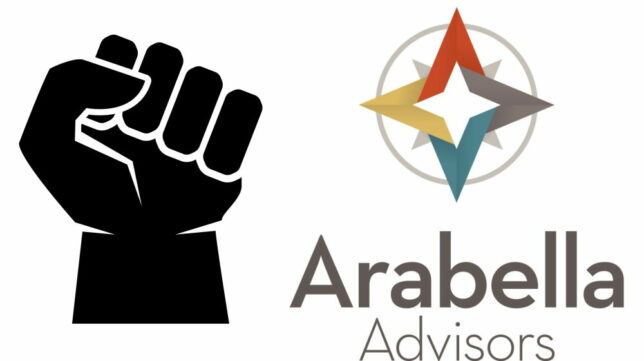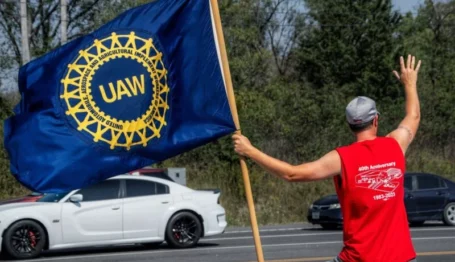Labor Watch
Big Labor Meets Arabella: A Coalitional Case Study


I have written extensively on the phenomenon of “social justice unionism” before. For those unfamiliar, social justice unionism is a theory of organized labor politics advanced by left-wing coalitional activists under which organized labor marches together with the social-liberal Left on noneconomic issues (like abortion and gender and sexuality). This is part of a broad left-wing front that labor supports in exchange for consideration and favors on organized labor’s core issues when the broad left-wing front holds power.
Practitioners of social justice unionism (like still-pending Labor Secretary nominee Julie Su) also argue that by participating in coalitions inspired by critical theory, labor unionists themselves might be turned to more left-wing positions than they would hold otherwise. Others suggest that Big Labor has “a conservative heart” and assert that “at least at a conceptual level, apart from families, trade unions are among the institutions in America most aligned with conservative principles and capable of advancing conservative ends.” Social justice unionism puts the ideological lie to that claim.
The lesson of social justice unionism is that institutions are policy—especially when the policy at issue concerns how much power an institution has. (Compare the old Washington maxim that “personnel is policy” regarding presidential appointments.) For a case study, let us consider the networks connecting the labor union movement to the Arabella Advisors network of “dark money.”
Follow the Money
The analysis can start at the surface. Each year, major labor unions must file extensive disclosures of their spending with the Department of Labor known as LM-2s after the government form on which they file. Those disclosures show substantial funding from Big Labor to the nonprofits in the core network that Arabella Advisors manages.
The largest recipient of Big Labor funds in the Arabella network is, perhaps not surprisingly, the Sixteen Thirty Fund. As a 501(c)(4) group, Sixteen Thirty can and does intervene directly with spending supporting Democrats and opposing Republicans. The SEIU has been involved with Sixteen Thirty since at least 2009, when the union reported giving $225,000 to the fund and receiving $376,000 from the fund. The SEIU also reported giving the largest contribution ($2,060,000) of any union to Sixteen Thirty Fund in 2021.
While SEIU’s contributions are the largest, other unions have contributed to Sixteen Thirty Fund, especially but not exclusively government worker unions. The three largest principally state-and-local government worker unions—the National Education Association (NEA) teachers union, American Federation of Teachers (AFT) teachers union, and the American Federation of State, County, and Municipal Employees (AFSCME) union of other government workers—have all funded Sixteen Thirty. Principally private-sector unions that have chipped into the Arabella network’s electoral advocacy arm include the Communications Workers of America, the United Farm Workers, Unite Here, and the United Auto Workers (through the UAW Community Action Program or CAP Council). The AFL-CIO union federation has also funded Sixteen Thirty but not since its 2017 reporting year.
The New Venture Fund (NVF), the principal charitable-projects arm of the Arabella network, is also a beneficiary of Big Labor’s beneficence with its members’ money. The SEIU remains a top contributor; in 2022, it reported $461,250 in spending on New Venture Fund. In 2013, the union provided NVF with just over $1 million. Other unions making six-figure contributions to NVF include the NEA in 2020 and AFSCME in 2016. The AFT, AFL-CIO, and International Brotherhood of Electrical Workers reported smaller expenditures.
Extended Connections
Direct funding of Arabella-managed groups is not the full extent of labor-Arabella ties. As the Arabella network matures, it has begun to spin off some of its fiscally sponsored projects into stand-alone advocacy groups. The most prominent is likely Demand Justice, a left-wing judiciary advocacy group that promotes court-packing, among other liberal judiciary-related causes. Sure enough, the SEIU contributed $50,000 to the group in 2022.
While most members of Arabella’s senior staff have backgrounds in conventional liberal political activism or management roles in Big Philanthropy, at least one formerly worked for labor unions. According to his Arabella bio, firm chief legal counsel Saurabh Gupta is a former deputy general counsel for the Massachusetts state teachers union (Massachusetts Teachers Association) and a former staff counsel for the Maryland teachers union (Maryland State Education Association).
Knowing Their Place
What all these connections and contributions yield is a coalitional dynamic. Thus, even though Big Labor is not the largest financial contributor to the Arabella network (liberal Big Philanthropy contributes far more than organized labor), Big Labor sees its interests served. We can observe this through the saga of Governing for Impact (GFI), a New Venture Fund project.
The principal (known) funder of Governing for Impact is the Soros Network, with the Open Society Foundations and Foundation to Promote Open Society providing the New Venture Fund with over $13 million to support GFI’s work. But that does not mean that Big Labor hasn’t been in the metaphorical “room where it happens” as GFI devises proposed regulatory policy for the Biden administration. As my colleague Parker Thayer, who helped expose GFI’s existence, has written:
At the head of every single GFI education policy memorandum are two names: Governing for Impact and the National Student Legal Defense Network (NSLDN). The NSLDN is a left-of-center advocacy group focused largely on college-debt forgiveness. The group helped GFI write a policy memorandum proposing student-loan forgiveness for the permanently disabled, which the Biden administration appears to have acted on.
. . .
In 2019, precisely when NSLDN began co-authoring education policy memorandums with GFI, the American Federation of Teachers (AFT), the country’s second largest teachers union, paid the NSLDN $100,000 for “advocacy.” A year later, the National Education Association (NEA), the largest teachers union, paid NSLDN another $150,000.
For playing along with the rest of the liberal coalition, Big Labor gets its back scratched. It’s coalition politics 101. In a GFI presentation, the group claimed credit for pushing the Biden administration to move on an independent contractor classification rule, a key organized labor priority that would open more jobs to organization into labor unions.
Conclusion
This brings us back around to the “institutions are policy” concept. Coalition dynamics dictate, as they have for over 100 years, that organized labor will be a faction of the American Left. Given that structure, the American Compass proposal to empower unions either by design or misadventure strengthens the Left, because Big Labor consists of institutions that support, develop, and enact left-wing policies.
And while many labor union members and union families might want that to change, institutionally Big Labor cannot and will not change. And the institutions develop, make, and enact policy. (Here one must recall that the New Venture Fund and American Compass share at least one major donor, the anti-free-market William and Flora Hewlett Foundation.)
Institutions are policy. Big Labor knows that. Arabella knows that. Do conservatives?



